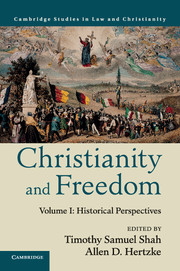Book contents
- Frontmatter
- The Religious Freedom Research Project
- Contents
- Contributing Authors
- Acknowledgments
- Introduction: Christianity and Freedom: Ancient Roots and Historical Innovations
- 1 The Roots of Religious Freedom in Early Christian Thought
- 2 The Christian Roots of Religious Freedom
- 3 Lactantius on Religious Liberty and His Influence on Constantine
- 4 Augustine and Religious Freedom
- 5 Christianity and the Roots of Human Dignity in Late Antiquity
- 6 Liberty of Conscience and Freedom of Religion in the Medieval Canonists and Theologians
- 7 Faith, Liberty, and the Defense of the Poor: Bishop Las Casas in the History of Human Rights
- 8 Calvinist Contributions to Freedom in Early Modern Europe
- 9 Constitutional Protection of the Freedom of Conscience in Colonial America: The Rhode Island and Pennsylvania Experiments
- 10 Christianity and Freedom in the American Founding
- 11 Vibrant Christian Pluralism and the Evolution and Defense of Religious Liberty in America
- 12 Orthodox Christian Contributions to Freedom: Historical Foundations, Contemporary Problematics
- 13 Christianity: A Straggler on the Road to Liberty?
- 14 Protestant Missionaries and the Centrality of Conversion Attempts for the Spread of Education, Printing, Colonial Reform, and Political Democracy
- 15 God and Freedom: Biblical Roots of the Western Idea of Liberty
- Index
3 - Lactantius on Religious Liberty and His Influence on Constantine
Published online by Cambridge University Press: 05 May 2016
- Frontmatter
- The Religious Freedom Research Project
- Contents
- Contributing Authors
- Acknowledgments
- Introduction: Christianity and Freedom: Ancient Roots and Historical Innovations
- 1 The Roots of Religious Freedom in Early Christian Thought
- 2 The Christian Roots of Religious Freedom
- 3 Lactantius on Religious Liberty and His Influence on Constantine
- 4 Augustine and Religious Freedom
- 5 Christianity and the Roots of Human Dignity in Late Antiquity
- 6 Liberty of Conscience and Freedom of Religion in the Medieval Canonists and Theologians
- 7 Faith, Liberty, and the Defense of the Poor: Bishop Las Casas in the History of Human Rights
- 8 Calvinist Contributions to Freedom in Early Modern Europe
- 9 Constitutional Protection of the Freedom of Conscience in Colonial America: The Rhode Island and Pennsylvania Experiments
- 10 Christianity and Freedom in the American Founding
- 11 Vibrant Christian Pluralism and the Evolution and Defense of Religious Liberty in America
- 12 Orthodox Christian Contributions to Freedom: Historical Foundations, Contemporary Problematics
- 13 Christianity: A Straggler on the Road to Liberty?
- 14 Protestant Missionaries and the Centrality of Conversion Attempts for the Spread of Education, Printing, Colonial Reform, and Political Democracy
- 15 God and Freedom: Biblical Roots of the Western Idea of Liberty
- Index
Summary
Why was the Roman Empire, a regime that film and media often portray as repressive, the first polity to promote a legal policy of religious liberty? This event did not happen in the early empire centered on the city of Rome. Nor did it occur in the Byzantine Empire under its autocrat enthroned in Constantinople. It transpired during the early fourth century, a transition period of soldier emperors from the Balkans who ruled jointly with several colleagues stationed in regional capitals such as Nicomedia (now Izmit, Turkey), Trier (Germany), and Milan. Some seventeen hundred years ago (in 313), one of these Balkan soldier emperors, the emperor Constantine, together with his partner Licinius (another such emperor), issued the first known edict of religious liberty. It was short-lived: In fact, the policy did not survive the end of Constantine's reign. Nevertheless, the reasons for its short life remain significant caveats for any multicultural society. I will first explore how this policy came about. Then I shall turn to the reasons that it guided Constantine's government for such a short time.
The fourth century of the Common Era did not begin auspiciously. In 303, after forty-some years in which Christians and other Romans had lived peacefully side by side, the emperor Diocletian – together with his three corulers – issued a series of edicts that gradually repressed the practice of Christianity. In Christian historiography, these edicts launched the so-called Great Persecution. Over the period of about a year, the emperors first ordered the destruction of all Christian churches, Scriptures, and church property and the cessation of assembly. Next Christians lost their citizen standing. A few months later a law demanded the arrest of Christian clergy. The fourth and final edict called for all Romans to sacrifice to the gods or face capital punishment. Note that here the emperors used sacrifice as a kind of litmus test. Whether it was a blood offering or the burning of incense, sacrifice was a ritual that Christian doctrine proscribed. Thus the emperors saw it as a useful way to test whether someone had returned to ancestral worship.
As it happened, Diocletian's three partners, each of whom ruled a different portion of the empire from a different capital city, enforced these decrees with varying degrees of enthusiasm.
- Type
- Chapter
- Information
- Christianity and Freedom , pp. 90 - 102Publisher: Cambridge University PressPrint publication year: 2016
- 2
- Cited by

